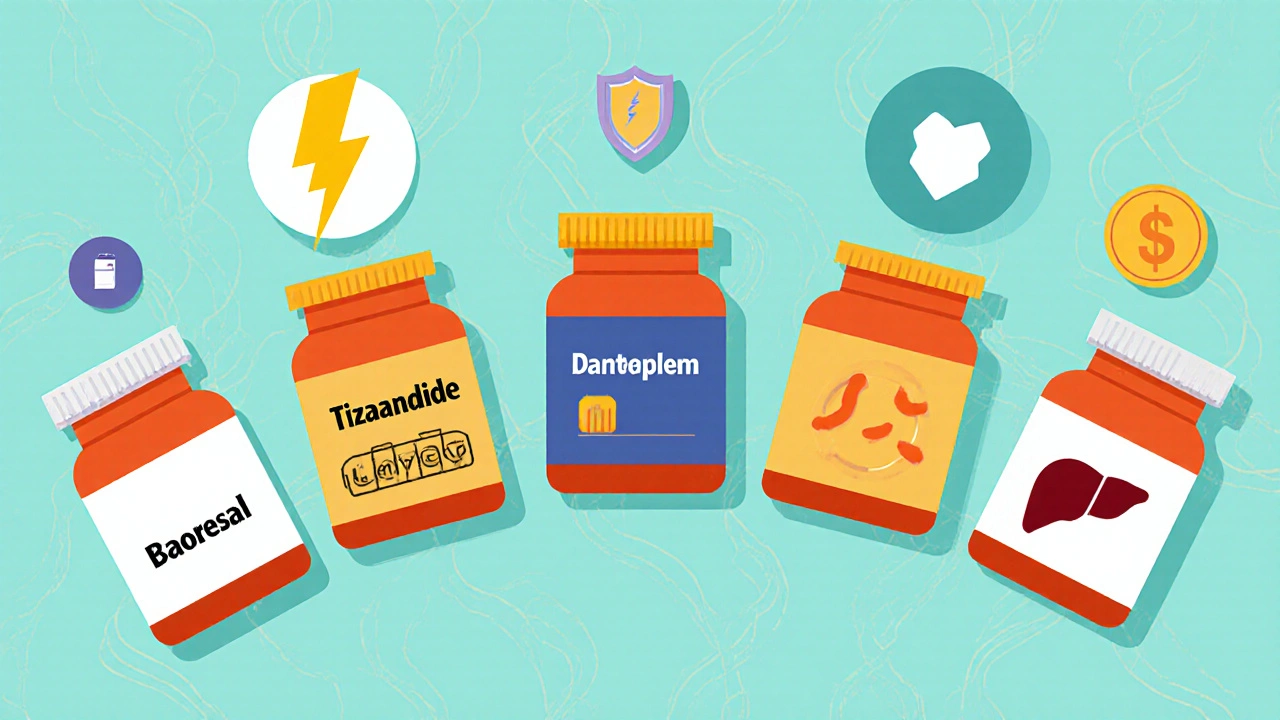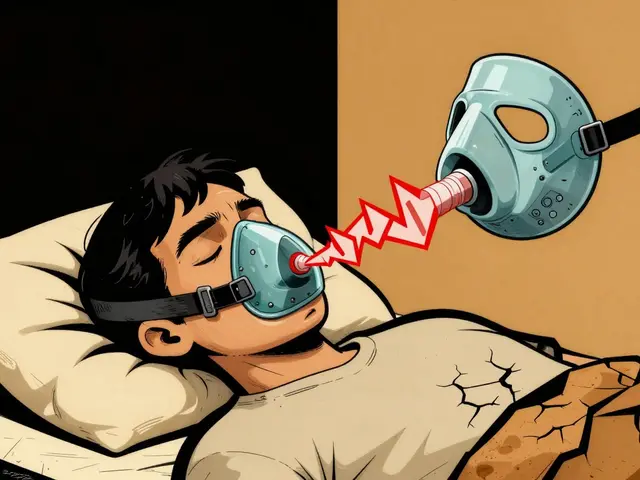Muscle Relaxant Comparison Tool
How to Use This Tool
Select your primary concern and condition to see which muscle relaxant may work best for you. The tool considers onset speed, safety profile, cost, and suitability for long-term use.
- Fastest Relief: Tizanidine offers quickest onset (30 min)
- Safety Profile: Baclofen and Gabapentin generally have fewer risks
- Lowest Cost: Diazepam and Baclofen are typically most affordable
- Long-term Use: Baclofen is well-studied for extended treatment
Always consult with your healthcare provider before making any medication changes.
Quick Take
- Lioresal (baclofen) is a GABA‑B agonist mainly for spasticity.
- Top alternatives include tizanidine, diazepam, dantrolene, and gabapentin.
- Consider drug class, onset speed, side‑effect profile, and cost when choosing.
- For rapid relief, tizanidine often wins; for chronic control, baclofen remains popular.
- Always discuss with a doctor, especially if you have kidney or liver issues.
When doctors prescribe muscle relaxants, Lioresal is the brand name for baclofen, a GABA‑B receptor agonist used to reduce spasticity in conditions like multiple sclerosis and cerebral palsy. But the market is crowded, and patients often wonder if there’s a better pill for their symptoms, price, or lifestyle. This guide breaks down Lioresal side‑by‑side with the most common alternatives, so you can see the pros, cons, and real‑world fit without wading through medical jargon.
What Exactly Is Lioresal?
Lioresal contains baclofen, which works by dampening overactive nerves in the spinal cord. By binding to GABA‑B receptors, it reduces the release of excitatory neurotransmitters, easing muscle tightness. The usual oral dose starts at 5mg three times a day and can be titrated up to 80mg daily, depending on tolerance.
Key points about baclofen:
- Approved in the UK by the NHS for spasticity caused by multiple sclerosis, spinal cord injury, and cerebral palsy.
- Onset of relief typically 1-2hours after dosing.
- Common side effects: drowsiness, dizziness, weakness, and sometimes low blood pressure.
Top Alternatives on the Market
Not every patient responds the same way to baclofen. Below are the four most frequently prescribed alternatives, each with a quick snapshot of how they differ.
Tizanidine is an α2‑adrenergic agonist that short‑circuits nerve signals, offering fast‑acting relief for spasticity. It’s taken 2-4mg up to three times daily, with a ceiling of about 36mg per day. Tizanidine’s advantage is a quicker onset (often within 30minutes) and a lower risk of severe weakness compared with baclofen. However, it can cause dry mouth, liver‑enzyme elevation, and marked sedation, especially at higher doses.
Diazepam is a benzodiazepine that enhances GABA‑A activity, delivering both muscle relaxation and anxiolysis. Doses range from 2mg up to 10mg three times a day. It works fast but builds tolerance quickly, and dependence is a real concern for long‑term users. Side effects include profound sedation, memory issues, and respiratory depression when combined with opioids.
Dantrolene is a direct-acting skeletal‑muscle relaxant that blocks calcium release from the sarcoplasmic reticulum. It’s prescribed at 25mg three times daily, maxing out at 400mg per day. Dantrolene shines for patients who can’t tolerate central‑acting agents because it works peripherally. The trade‑off is liver toxicity - regular liver‑function tests are mandatory.
Gabapentin is an anticonvulsant that modulates calcium channels, often used off‑label for neuropathic pain and spasticity. Typical doses start at 300mg three times daily and can climb to 1800mg/day. It’s less potent for pure spasticity but helps when pain and nerve irritation coexist. Main drawbacks: balance problems, swelling, and possible weight gain.
Side‑Effect Profiles at a Glance
| Drug | Class | Typical Dose | Onset | Common Side Effects | Monthly Cost (≈£) |
|---|---|---|---|---|---|
| Lioresal (baclofen) | GABA‑B agonist | 5‑80mg/day | 1-2h | Drowsiness, weakness, hypotension | £12‑£20 |
| Tizanidine | α2‑adrenergic agonist | 2‑36mg/day | 30min | Dry mouth, liver enzyme rise, sedation | £15‑£25 |
| Diazepam | Benzodiazepine | 2‑30mg/day | 15‑30min | Dependence, memory loss, respiratory risk | £8‑£14 |
| Dantrolene | Direct muscle relaxant | 25‑400mg/day | 1‑2h | Liver toxicity, nausea, weakness | £20‑£35 |
| Gabapentin | Anticonvulsant | 300‑1800mg/day | 1‑2h | Dizziness, swelling, weight gain | £10‑£18 |

How to Choose the Right Muscle Relaxant
Picking a pill isn’t just about “which one works best.” You need to weigh several practical factors:
- Underlying condition - If you have multiple sclerosis, baclofen and tizanidine have the strongest evidence. For spinal‑cord injury with liver concerns, gabapentin may be safer.
- Speed of relief - Tizanidine offers the fastest onset; if you need immediate night‑time relief, it’s a good add‑on.
- Side‑effect tolerance - Sedation may be acceptable for bedtime dosing but not for daytime work.
- Drug interactions - Combine diazepam with opioids only under strict monitoring due to breathing risk.
- Cost and insurance coverage - NHS typically prefers baclofen and diazepam for generic pricing; newer brand‑name options may need private funding.
Talk with a physiotherapist or neurologist about a trial period. Most doctors start low, watch for side effects over a week, then adjust. Keep a simple log: dose, time, pain/soreness rating, and any new symptoms. That data makes the next appointment much clearer.
Special Populations & Safety Tips
Pregnant women should avoid benzodiazepines like diazepam unless the benefit outweighs fetal risk. Baclofen is category B in the UK, but still requires medical oversight.
Elderly patients often experience exaggerated drowsiness with central‑acting agents. Starting at half the usual adult dose and titrating slowly cuts fall risk.
Kidney impairment raises gabapentin levels; dosing every other day may be required. For liver disease, skip dantrolene and watch liver enzymes for tizanidine.
Managing Discontinuation
Stopping baclofen abruptly can trigger rebound spasticity and seizures. A taper of 5mg every 2-3days is the standard. The same caution applies to tizanidine and diazepam - a gradual reduction prevents withdrawal symptoms.
Bottom Line
If you need a well‑studied, affordable option for chronic spasticity, Lioresal alternatives like baclofen stay front‑line. For rapid night‑time relief, tizanidine often feels smoother. When liver health is a concern, gabapentin or low‑dose diazepam may be the compromise. Always loop in your prescriber before swapping, and keep a symptom diary to fine‑tune the regimen.
Frequently Asked Questions
Can I take Lioresal and tizanidine together?
Combining two central‑acting relaxants can boost sedation and lower blood pressure. Some specialists use a low‑dose tizanidine at night while keeping a stable baclofen dose during the day, but only under close monitoring.
Is baclofen safe for long‑term use?
Yes, many patients stay on baclofen for years. Periodic liver function tests are recommended, and doctors watch for muscle weakness that could affect mobility.
Why does my doctor suggest gabapentin for spasticity?
Gabapentin isn’t a classic muscle relaxant, but it dampens nerve firing that can contribute to spasticity, especially when pain is present. It’s useful when you need both pain control and modest tone reduction.
What should I watch for with dantrolene?
Liver enzyme spikes are the biggest red flag. If your ALT or AST climbs above three times the normal range, stop the drug and get a liver work‑up.
How quickly will I feel relief after a dose?
Baclofen and dantrolene take about 1-2hours. Tizanidine can start within 30minutes, while diazepam may work in 15-30minutes. Gabapentin usually needs a couple of hours to hit steady levels.







Cierra Nakakura October 2, 2025
If you’re hunting for quick relief, Tizanidine is the sprint runner 🏃♀️- hits in about 30 min! For daily maintenance, Baclofen keeps the tempo steady. 🎶
Sharif Ahmed October 9, 2025
One must contemplate the very ontology of muscle relaxation, for it is not merely a pharmacologic convenience but a symphony of neurochemical orchestration. Baclofen, under the guise of Lioresal, adorns itself with the modesty of a GABA‑B agonist, yet its effect on spasticity echoes the measured cadence of a classical concerto. In stark contrast, Tizanidine bursts onto the scene like an avant‑garde jazz improvisation, delivering relief within half an hour, a temporal alacrity that borders on the theatrical. Diazepam, shackled by its benzodiazepine lineage, offers swift surrender but at the price of a creeping dependence that could rival the most insidious of tragic heroes. Dantrolene, the peripheral stalwart, eschews central mechanisms, instead modulating calcium flux with the solemnity of a baroque fugue, though its hepatic toxicity demands vigilant surveillance. Gabapentin, an anticonvulsant turned reluctant spasm mitigator, lingers in the shadows, its benefit manifest when pain intertwines with tone. The economic tableau paints diazepam as the thriftiest, a pauper’s promise, while baclofen and tizanidine reside in the modest middle class, and dantrolene commands a premium akin to a patron of the arts. Safety profiles, however, are not mere statistics but narratives of patient lived experience, where drowsiness may become a nocturnal lullaby or a daytime hazard. When one weighs onset speed against long‑term sustainability, the decision resembles a literary critique, parsing character arcs and thematic resonance. Moreover, the specter of hepatic insult looms over tizanidine, demanding liver function panels as one would demand footnotes in a scholarly treatise. The clinician’s armamentarium, thus, is a palette of hues, each shade offering a distinct chromatic contribution to the therapeutic canvas. Patient preference, an often underappreciated brushstroke, can tip the balance between baclofen’s steady reassurance and tizanidine’s fleeting exhilaration. In the grand tableau of spasticity management, no singular agent attains supremacy; rather, the confluence of dosage titration, comorbidities, and psychosocial context dictates the ultimate masterpiece. Hence, to proclaim an unequivocal champion would be as presumptuous as declaring a single author the sole voice of an entire literary epoch. Therefore, the astute practitioner embraces a patient‑centered algorithm, iteratively adjusting the regimen until harmony is achieved.
Charlie Crabtree October 16, 2025
Hey folks! 🙌 If you’re starting a new muscle‑relaxant trial, remember to keep a simple log-dose, time, how you feel. Small tweaks can make a huge difference, and sharing your notes here helps everyone find the sweet spot. You’ve got this! 🌟
RaeLyn Boothe October 23, 2025
Your table omits a column for pediatric dosing.
Fatima Sami October 30, 2025
The phrase should read ‘Your table omits a column for pediatric dosing’ rather than ‘misses’. Proper verb choice enhances clarity.
Arjun Santhosh November 6, 2025
i think adding a note about liver tests for tizanidine is a good idea lol
Stephanie Jones November 13, 2025
In the quiet corridors of pharmacology, each pill is a whisper of humanity’s attempt to tame the restless body, a fleeting promise that the tremor of existence may one day be soothed.
Nathan Hamer November 20, 2025
Indeed-one could argue that the very act of prescribing a muscle relaxant is a metaphysical negotiation with the self; the physician, as a reluctant sorcerer, summons chemical allies, and the patient, a weary traveler, places trust upon these fleeting talismans; the outcome, however, rests upon the delicate balance of dosage, metabolism, and the inexorable march of time; thus, each tablet becomes a stanza in the epic poem of recovery, echoing through the sinews of consciousness; and as we observe the subtle ebb and flow of spasticity, we are reminded that medicine, at its core, is both art and alchemy-an eternal dance between hope and restraint.
Tom Smith November 27, 2025
Oh, great, another spreadsheet comparing costs-because nothing says “patient‑centered care” like picking a drug based on a grocery‑store receipt. 🙄
Kyah Chan December 4, 2025
While the sentiment expressed may hold a kernel of truth regarding the potential oversimplification inherent in cost‑centric comparisons, it remains indisputable that economic considerations constitute a nontrivial factor in therapeutic decision‑making, particularly within publicly funded healthcare systems where budgetary constraints directly influence drug accessibility and formulary inclusion. Consequently, a balanced appraisal encompassing both pharmacodynamic efficacy and fiscal impact is imperative to formulate an optimal, evidence‑based regimen.
Ira Andani Agustianingrum December 11, 2025
Remember, consistency beats perfection. Keep taking your meds as scheduled, track how you feel, and bring those notes to your next appointment-your doctor will appreciate the data.
James Higdon December 18, 2025
From an ethical standpoint, it is incumbent upon healthcare providers to ensure that patients are equipped with transparent information and are empowered to engage actively in shared decision‑making, thereby honoring the principle of respect for autonomy.
Wanda Smith December 25, 2025
They don’t want you to know that the pharma giants are quietly steering research toward drugs that keep you dependent, masking the real solutions in plain sight.